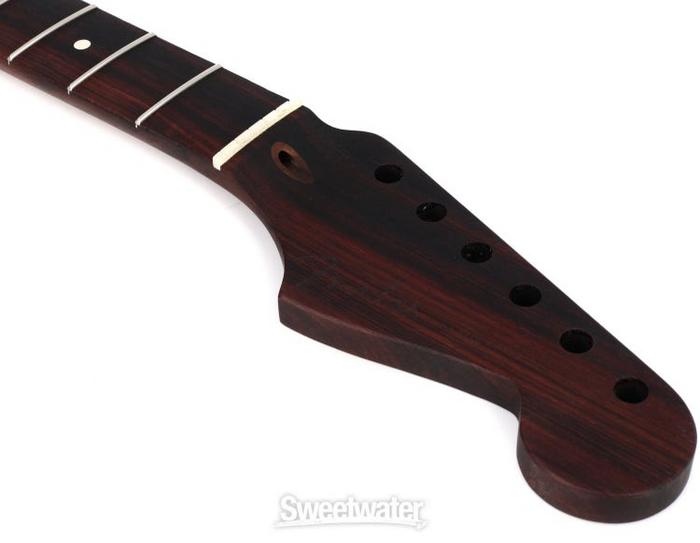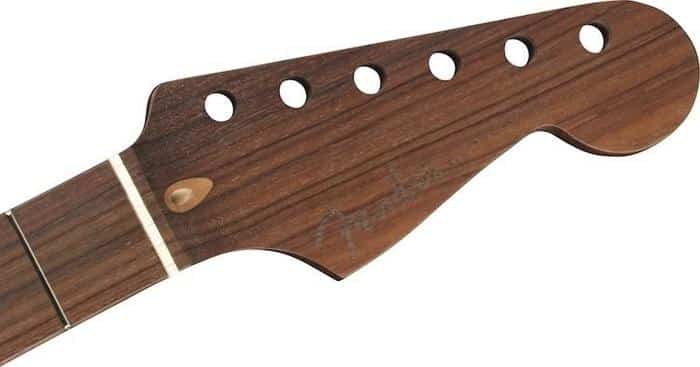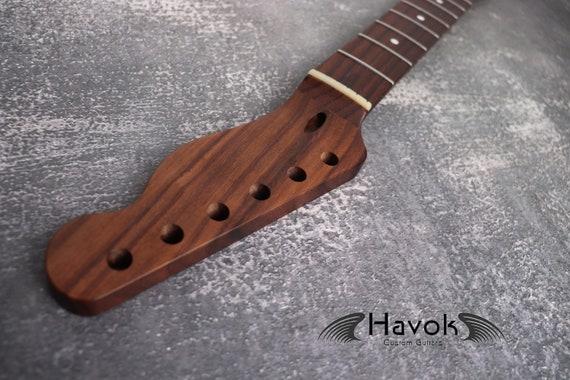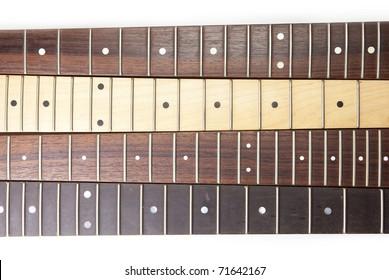Imagine strumming your first chord on a brand-new guitar, only to be captivated by the warmth and resonance emanating from its rosewood neck. This was my experience, and it marked the beginning of an enduring journey into the world of guitar neck materials. As a musician and guitar enthusiast, I’ve realized that the choice of neck wood significantly influences the instrument’s playability and tone.
By delving into the *comprehensive guide to rosewood guitar necks*, I’ll share not just technical insights, but personal discoveries that underscore the importance of this fascinating component in **guitar construction**. R.M. Mottola’s research highlights a crucial aspect: selecting the right neck material is a vital decision—one that can unlock new dimensions in your musical expression. As we explore the allure and mechanical benefits of rosewood, from its rich tonal qualities to its impact on your playing style, you’ll gain a nuanced understanding of why so many seasoned musicians continue to favor it.
What is a Rosewood Guitar Neck?

Many musicians swear by the rich, warm tone of rosewood—what makes this wood so special? With years of experience in lutherie, I have come to appreciate the allure of a rosewood guitar neck. Renowned for its stunning visual allure and superior resonant properties, rosewood has carved out its niche as a favorite among guitar makers and players alike.
A rosewood guitar neck is crafted from one of the most revered tonewoods in the guitar world. Its deep, natural hues range from chocolate browns to purplish-black streaks, setting the aesthetic bar high. However, beyond its visual splendor lies the true magic—rosewood’s sound quality. This dense wood is prized for its ability to emphasize mid to low frequencies, which brings out a fuller, rounder sound. As a master luthier, I’ve observed how these qualities translate into instruments that resonate with warmth and sustain, delivering a sound that’s both mellow and profound.
The choice of rosewood for a guitar neck reflects an understanding of how materials impact sound. Unlike some other woods, rosewood offers a smooth playing surface, making it not only a visual delight but also a tactile joy. In my hands, and for many others, these qualities forge a connection with the music that’s truly special. This intimate blend of aesthetics and acoustics continues to drive the enduring popularity of rosewood, making it a perennial choice for those seeking an exceptional instrument.
Why Choose Rosewood for Your Guitar Neck?

Is the allure of rosewood just its looks, or does it offer real advantages in sound and playability? As someone who has spent a great deal of time immersed in the nuances of guitar construction, this question has been central to my exploration of guitar neck materials. Choosing rosewood for your guitar neck is not just about its undeniable visual appeal; the benefits run much deeper, rooted in its incredible properties that elevate both the instrument’s sound and the player’s experience.
Rosewood boasts an exceptional sound quality that is hard to match. Its natural resonance and distinct tonal warmth offer a full-bodied sound, enriching every note and lending a mellow richness that’s particularly cherished among seasoned musicians. When you opt for a solid rosewood neck, you’re investing in more than just durability; you’re shaping the very essence of your music.
The comfort of a rosewood neck is something any guitarist will immediately appreciate. Its smooth, tactile feel provides ease of play, making intricate chords and fast solos feel remarkably fluid. This comfort, combined with its aesthetic elegance, reinforces rosewood’s standing not only as a robust choice but a sophisticated one too. As noted by R.M. Mottola, the unique blend of strength and allure that rosewood offers truly provides guitarists with an unmatched playing experience.
For those seeking longevity, sonic excellence, and comfort in their guitars, rosewood proves to be an unbeatable choice. Transitioning into our exploration of who favors this celebrated wood, it’s clear why rosewood is cherished by guitarists worldwide.
Who Uses Rosewood Guitar Necks?

From rock legends to jazz virtuosos, whose hands are shaping the sound of rosewood guitar necks? This question brings us to the heart of who chooses these *custom guitar necks* and why they gravitate towards the distinctive rosewood fingerboard. As someone who has spent years observing and interacting with professional musicians, I’ve seen the allure of rosewood firsthand. Its rich tonal qualities and natural comfort make it a popular choice for artists across genres.
Whether it’s the soulful bends of a blues guitarist or the intricate licks of a jazz technician, musicians often favor rosewood for its versatility and tactile response. The warm, resonant sound compliments many styles, making it the neck of choice for live performances where *expressive* playability is crucial. Rock players, with their energetic riffs, and classical musicians, with their precise techniques, find the wood’s attributes particularly beneficial.
This personal insight into the community of players reveals a shared appreciation for the *expressive tonal qualities* that only rosewood can bring. The presence of this wood in an artist’s toolkit enhances their ability to convey emotion, character, and precision, marking it as a beloved choice even among demanding musicians.
Where to Buy Rosewood Guitar Necks?

Not all guitar necks are created equal—where can you find the best rosewood options? Finding *high-quality rosewood guitar necks* is an art in itself, and as an editor for string instrument journals, I’ve had the privilege of exploring various suppliers. One of the first places I turn to is *reputable sellers* known for their expertise in *guitar neck materials* and guitar construction. It’s pivotal to seek out suppliers who specialize in these specific domains, as they have the knowledge and *experience needed to craft superior instruments*.
I often recommend established vendors like StewMac and Warmoth, renowned for their consistency and commitment to quality. These suppliers prioritize sourcing their rosewood from sustainable sources, ensuring that each guitar neck not only sounds authentic but is environmentally responsible. Moreover, local luthiers can be a treasure trove of quality and *craftsmanship*, bringing a personal touch to each piece they create. Their deep understanding of *tonewoods* can offer a customized neck that truly resonates with your sound preferences.
Remember, it’s not just about finding a rosewood neck; it’s about choosing a piece that aligns with your musical journey. By considering these options, you’re ensuring that the essence of your guitar is as authentic as the music it produces, giving you an instrument that’s both beautiful and enduring. As we delve into personal experiences, it’s clear that selecting the right neck is more than a purchase—it’s a commitment to quality and *artistry*.
Comparison: Rosewood vs Maple

In the world of guitar necks, the choice between rosewood and maple often sparks passionate debate. **In the battle for the best guitar neck, is it really a contest, or do both woods serve unique purposes?** This question cuts to the core of guitar craftsmanship, where every player’s preference plays a pivotal role in defining their sound. With years of experience in the field, I’ve come to admire both materials for their distinct attributes.
As R.M. Mottola insightfully notes, maple’s appeal lies in its ability to produce a bright, sharp sound. It’s a popular choice for players seeking a tone that punches through a mix with clarity and precision. However, this brightness can sometimes feel too harsh if you’re venturing into softer or more mellow genres.
On the other hand, the charm of rosewood is in its warmer, richer tones—perfect for those who appreciate a more intricate, full-bodied sound. When cradling a rosewood neck, I often feel connected to a depth that’s either lost or different with maple. This wood not only influences the tonal quality but also contributes significantly to guitar neck stability.
Ultimately, the choice between rosewood vs maple depends on your playing style and desired sound. Whether you sway towards the bright notes of a maple neck or bask in the warmth of rosewood, each material serves its unique purpose, enhancing the vast diversity of musical expression.
How to Maintain Your Rosewood Guitar Neck
Cleaning Tips

Proper *guitar maintenance* is crucial to preserving the sound and *longevity* of your instrument. When it comes to *rosewood neck care*, cleaning techniques play a pivotal role. Could the wrong cleaning technique ruin your guitar’s neck? Let’s find out. Here, I dive into the essentials of cleaning, highlighting insights from experts and personal experience.
To start, always use the right cleaning agents. As a *trusted luthier*, R.M. Mottola advises specific products to maintain the natural oils of rosewood, which can *enhance its life and tone*. Avoid household cleaners; instead, opt for those designed for rosewood. A soft, damp cloth is often enough for routine cleaning, gently wiping away dirt without stripping oils.
Moreover, never saturate the neck. Excess moisture fosters warping, undermining the structural integrity of your guitar. Cleaning should be a careful, deliberate process, ensuring that every touch contributes to your instrument’s health and harmony. Remember, with the right care techniques, a rosewood neck not only sustains but thrives, rewarding you with unparalleled resonance and playability.
Conditioning and Oiling

When it comes to guitar neck care, conditioning and oiling your rosewood neck is crucial. But why is conditioning your rosewood neck not just an optional chore, but a critical maintenance step? With my background in instrument acoustics, I’ve learned that rosewood’s unique tonal characteristics are deeply intertwined with its natural oils and moisture.
To properly maintain these essential qualities, regular fretboard maintenance through conditioning is imperative. Conditioning rejuvenates the wood, preventing it from drying out and becoming brittle. I typically recommend using high-quality lemon oil or dedicated fretboard conditioners. These products soak into the wood, replenishing lost moisture and ensuring optimal playability and sound.
Furthermore, proper oiling forms a protective barrier against grime and sweat, keeping your neck smooth and comfortable. With each application, the natural luster of rosewood is enhanced, elevating both its aesthetic appeal and its tactile response. Transitioning from cleaning to conditioning isn’t just a procedure; it’s a commitment to the longevity and vibrancy of your instrument, ensuring your rosewood guitar neck sings beautifully for years to come.
User Opinions and Experiences

As a luthier and an avid guitarist, I’ve spent countless hours contemplating every detail of guitar craftsmanship, yet the allure of the rosewood guitar neck continues to captivate me. Amidst technical discussions and tonal debates, I often ponder: What do musicians truly think about rosewood necks—are they a game changer or just hype? From my conversations with fellow players and my own experiences, I believe the answer is both straightforward and complex.
Players who favor rosewood necks often highlight their unparalleled guitar neck comfort. Unlike other woods, rosewood provides a unique tactile feel that many describe as naturally smooth and velvety. When I run my hand along a rosewood neck, the wood’s subtle texture and warmth are immediately palpable, offering a reassuring grip that complements intricate fingerwork. This comfort level can be a decisive factor for those who spend hours refining their craft.
Tonal richness is another aspect where rosewood necks shine. The dense grain structure contributes to a balanced spectrum of deep, resonant lows and sparkling highs, a tonal quality that elevates both the expressive capabilities and the overall sonic texture of a guitar. In my many years working with musicians, the consensus has been that rosewood’s tonal blend is distinctive, enhancing the instrument’s voice in a way few other materials can.
Ultimately, the choice of a rosewood neck often boils down to a matter of personal preference intertwined with practical requirements. My insights, gathered from numerous dedicated players, underscore that while some may consider rosewood a luxury, for many it is an essential feature in their musical journey—a testament to its enduring appeal.
FAQs
What are the benefits of using rosewood for guitar necks?
How does rosewood compare to other woods for guitar necks?
Are there any maintenance tips for rosewood guitar necks?
Conclusion
As we wrap up, what lasting impression does rosewood leave on the world of guitar craftsmanship? Through this journey, I have reaffirmed the unique position that a rosewood guitar neck holds in the pantheon of tonewoods. Its rich tonal quality and striking appearance make it a perennial favorite among both seasoned luthiers and amateur musicians. From exploring its definition to dissecting why it’s such a renowned choice, we’ve spanned the broad spectrum of experiences and opinions held by players and builders alike.
With its unmatched balance between beauty and playability, rosewood stands as a true testament to expert craftsmanship and enduring legacy. While alternatives like maple offer their own advantages, rosewood’s combination of warmth and clarity is unattainable elsewhere. Whether seeking to purchase, maintain, or simply admire, knowing the nuances of rosewood enhances appreciation infinitely. Every strum on a rosewood neck echoes a tradition of quality and artistry that transcends mere function, making it not just an essential component but an emblem of guitar-making excellence.

R.M. Mottola, an engineer-turned-luthier, revolutionizes stringed instrument design with his deep focus on acoustics and ergonomics since 1994. As editor of the Savart Journal and a key contributor to American Lutherie, Mottola merges science with artistry in lutherie. He enriches the field with his extensive knowledge, shared through his Liutaio Mottola website, making him a beacon in the world of modern instrument craftsmanship.
